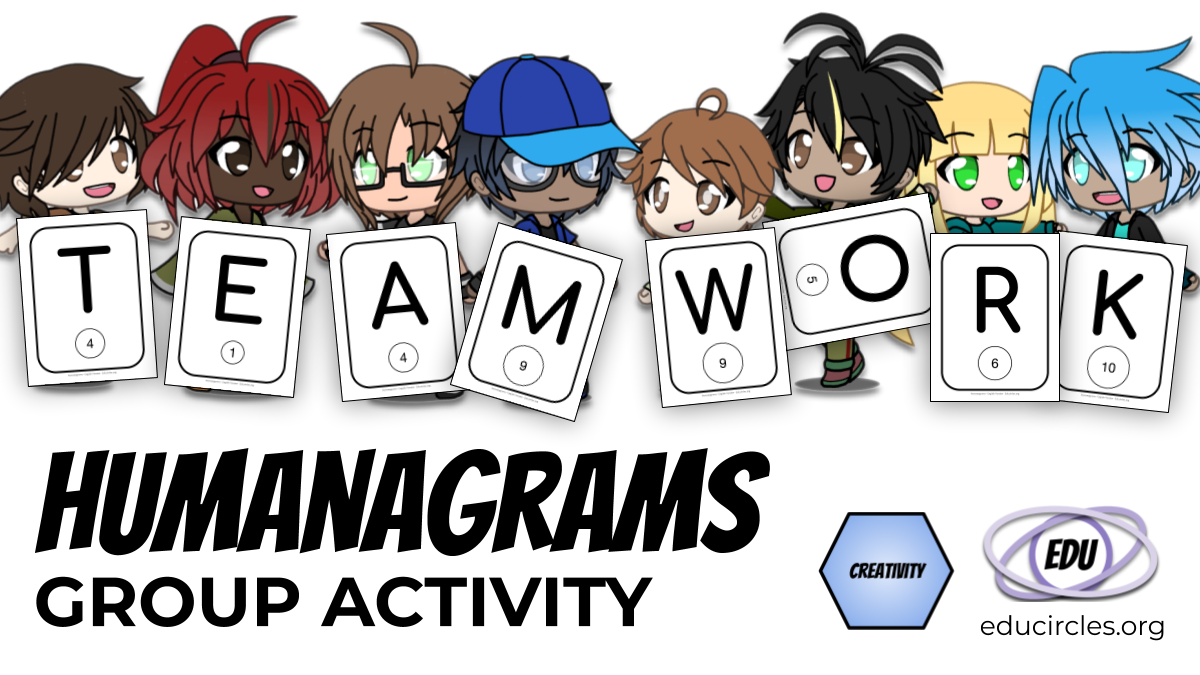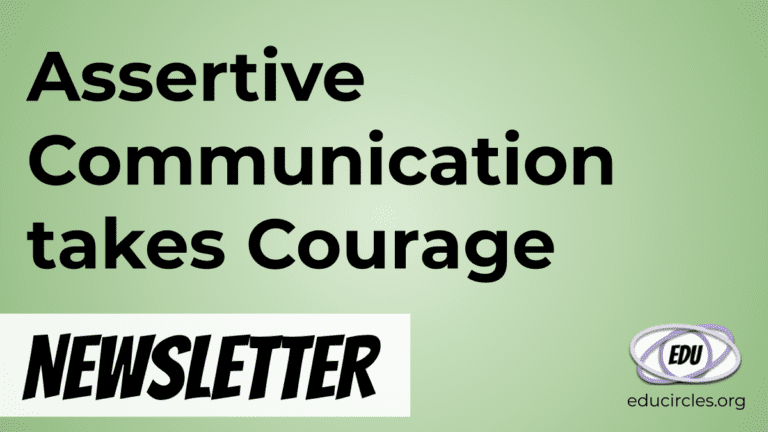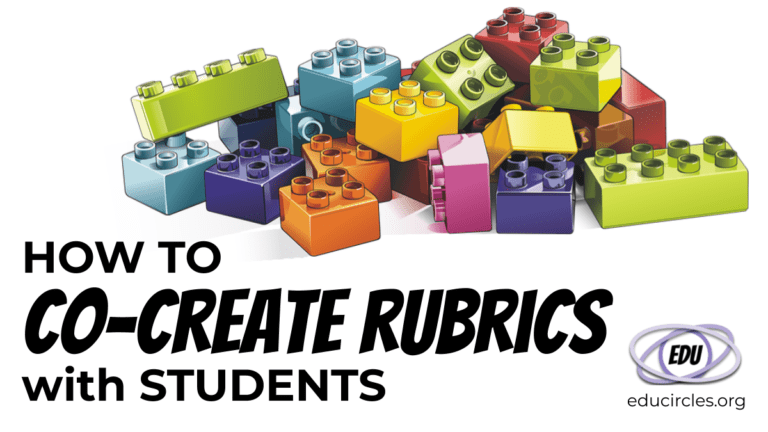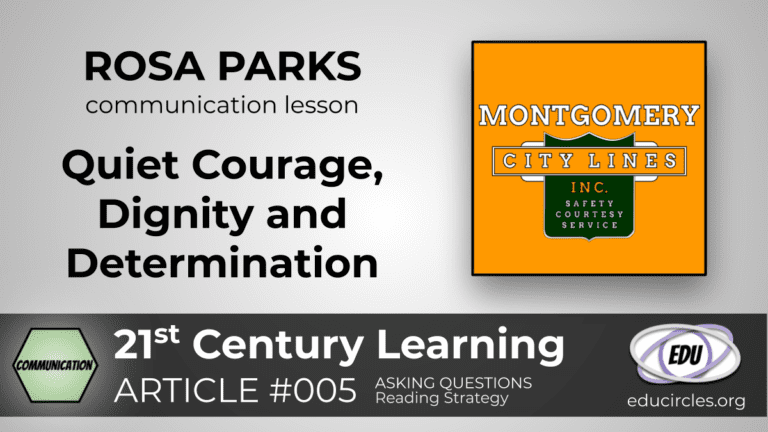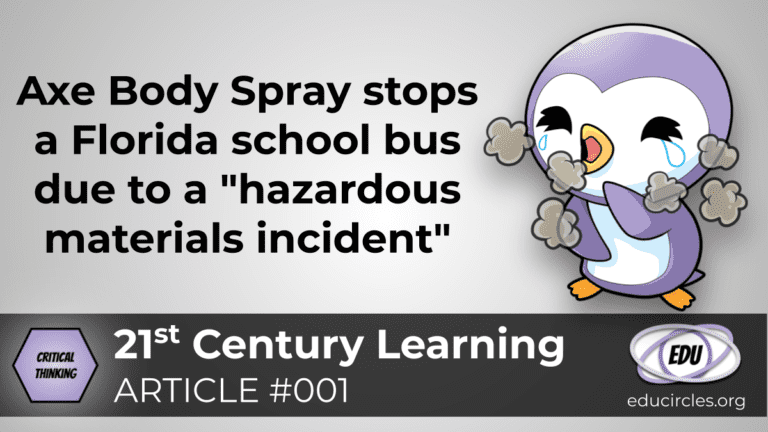Humanagrams! FREE Class Teamwork Group Activity
Need a quick activity to do with your class?
Why not play Humanagrams?
Activity overview:
- Students try to combine letters in different ways to make words.
- There is a class set of 31 letters on regular paper (8.5” x 11”): 26 letters in the English alphabet and each vowel has 2 copies.
Learning objective:
- Practice collaboration and communication
- Practice creativity and tinkering
- Explore diversity and inclusion
Guiding prompts:
- How many words can the class spell?
- What is the longest word that the class can spell?
- What is the shortest word?
- What is the highest point word that you can spell?
- What is the lowest point word that you can spell?
Discussion:
- If this was a metaphor for inclusion, do some letters get included more than others? Why? (yes, vowels in every English word. )
- Are some letters not included as often? Why not? (Not as many words that use that letter.)
- How could we include these letters more? (Give them more points / worth more so that people want to use them. In other words, recognize and see the value in others.)
- Take home message – sometimes, we don’t include people, because we don’t see value in them / we look down on them. How can we get to know people, so we see that we have things in common, so we want to include them?

The back story: An example of the Creative Process
Question: Where did the idea for Humanagrams come from?
This is not a new idea. We just put an Educircles spin on this activity and connected the dots between different ideas, but teachers have been doing wordplay activities like this for ages.
I did this activity with my grade 8 class in November 2017. (Actually, I left this activity for my supply teacher to do, but I’ve done this activity in the past.)
I also shared a rough version of this activity with my colleagues. At the time, I think I might’ve called it Human Scrabble, but we’ve gone in a slightly different direction here. You know, trademarks and all that.
Question: Where does the name Humanagrams come from?
That’s a great question! I think I like the name, but I’m not sure.
Recently we shared another back-to-school icebreaker that we use called Human Bingo. I like to do that activity a lot at the start of the school year. When I do it with my students, I use it as an opportunity to teach small talk and do our first lesson on oral communication.
But, I don’t love the name Human Bingo. And my daughter pointed out, it’s kinda creepy. It is, I guess.
So, in this activity, since we couldn’t use the name Human Scrabble, I thought about other word games.
I really like the game Bananagrams. My friend introduced it to me. It’s like Scrabble, but without the pressure of having to memorize a whole bunch of obscure two- and three-letter words. You play it on the table, and you build words in crossword fashion but you can go in any direction, so there’s a lot of flexibility. You’re not constrained to the Scrabble board!
What I really like about Bananagrams is how you get to play around with words. So for example, if you have a word, but you need a letter somewhere else, you can take the letter and slide it into a different spot. (But then you have to make sure that you spell a proper word with the leftover letters from the old word, or you’re a rotten banana!)
So, the words are constantly changing. It’s a great lesson to teach creativity because you’re playing and trying out different possibilities.
I was stuck for a name, and that’s when my friend suggested Humanagrams as a name for this activity which works because that’s what you get when you mash humans and anagrams together. (I imagine that’s how the name Bananagrams came to be as well… but, bananas are mushier.)
QUESTION: What’s with the points? How did you figure out the scoring?
Wikipedia has a fantastic article about letter frequency in different languages.
I guess people have been studying frequencies of letters for code breaking and cryptoanalysis for a while now (among other things.)
I would’ve thought that the vowels – A, E, I, O, U – would’ve have the highest frequency in English words, but it turns out that the letter T is used more often than letter A. (And that letter U, well, it’s halfway down the list.)
So, I put the letter frequencies into a Google spreadsheet, and started playing around with formulas, trying to figure out a way to turn the letter frequencies and the points.
- At first, I thought I could just use the frequency percentages and figure out the opposite (how unlikely were these letters to show up in the alphabet.) But, that got me a lot of percentages all close together up near a hundred percent.
- Then, I thought about looking at the highest frequency letter which is the letter E – it apparently shows up 13% of the time in English words.
- So then, I took 13% as a base and I subtracted all the frequencies from that and that gave me a nice range of percentages spread more evenly across from zero all the way the 100%. (I wanted to find a way to get points ranging from 1 to 10 but not all have them at the same point level.)
- I then used that range of percentages to figure out points out of 10. That was nice but I got a lot of decimals, so I chose to round the numbers.
- But, that meant that the letter E would’ve rounded down to zero and no kid’s gonna want to be worth zero points, so in Excel, there’s a function called round up and that meant all the decimal numbers rounded up to the nearest whole number. And, those whole numbers became points.
QUESTION: How did you figure out the layout for the Humanagrams cards?
Well, when I first did this assignment a year ago, I was thinking like Scrabble tiles. With the big letter in the middle and the point value in the bottom right.
But, since we’re coming up with our own Educircles version of a creative wordplay game, we wanted to change the cards up a little bit.
Having a huge letter in the middle was important so that kids could see the letter from any seat in the class. So, I played around with a bunch of fonts.
- First, I tried the bangers font which is the font that we use in most of our Educircles products, but it didn’t work. I like the comic book look of it, but the font is too dark and heavy and thin and it’s hard to see clearly from the back.
- So, then I tried the Calibri font which is the text font that we use in our slideshows. (I think at the time, we chose the Calibri font because it was a little bit narrower than the other fonts and that helped us squeeze in more words on the slideshow.)
- But on the card, we wanted to have a nice, visible, wide font that people could see from the back, so Calibri didn’t work for us either.
- Next, I played around with Arial and Comfortaa. I was working around with Comfortaa because that’s a nice large font, and actually the lower case letter a is the regular round a that we teach in kindergarten, and I was thinking that eventually I’d like to have a version of this Humanagrams game for little kids with easier math (i.e. points worth 5, 10, 15.) So, I went with Comfortaa.
- (Actually, later on, I discovered I really prefer Helvetica because it’s a nice familiar large bold look, but at that point, I had done too much work and I was running out of time and I didn’t want to go back and switch all the fonts from Comfortaa to Helvetica. Meh.)
Since, I didn’t want to have the number point in the bottom right corner because that’s too much like Scrabble, I wondered how it would look like if the points were centered.
It didn’t look bad, but initially the letter was too close to the number, so I decided to move the letter up so it’s not centered in the card but it is still centered horizontally.
And then I wanted to figure out a way to draw attention to the points because that’s a big part of the game as well. Some points are worth more than others and that’s sort of a metaphor later on about diversity and inclusion and how do we see value in people (and less commonly used letters), so I decide to put a circle around it to highlight the point subtly.
I thought a circle would look good because the title itself has a rounded rectangle around it. I didn’t think a square around the points would look good because the harsh corners of the square wouldn’t really fit with the round the corners of the rectangle on the card.
TEACHER TIP: Oh, by the way, all of this was designed using Google slides, and I just saved it as a PDF. I love Google slides. It is more than just for slideshows. You can change the page set up so that the slides are 8.5 x 11″, so regular paper, And then all of a sudden your spreadsheet program becomes a graphics program. Google slides is what I used to design all of my stuff.
I played around with the size of the circles. One of the really cool things about the Humanagram cards that you may not notice right away is that the size of the circle changes based on the size of the points.
- I don’t think people would notice it right away when you’re just looking at your own card.
- But once a few students have lined up together and the class is looking at that. We’re trying to figure out another word that you could use…
- In my head, I had a picture of one of my old students being really excited and noticing that: “Wait a second! The circles are all different sizes!” Like it would be this great aha moment.
So, once I knew that I wanted the circles to match the point sizes, I had to play around and figure out the largest circle I could have and then figure out the smallest circle I could have. And then I used math to figure out the different circle sizes for all 10 points.
QUESTION: This looks like a lot of work!
It was, but I was really excited as I was doing it. I really like making things look pretty on the computer, so I had some tricks that I have figured out before to help me with this.
For example, one of the tricks that I use with Google slideshows is that I use the master slide feature.
- It lets you change the layout and create your own layouts.
- This makes it easier to change things: if you don’t like something, you just change it on the master slide, and it will change all of the slides that use that layout.
So, I played around with a few different possible layouts.
And then, once I found the layout that I really like – the black rounded rectangle on the outside to identify the tile, the large Comfortaa font for the main letter in the middle, and the idea of a number with points at the bottom middle…
Once I figured that out, I could create that into a master slide layout to use with all of the different letters.
The thought of having to make the different circles on each letter slide was kind of daunting.
I didn’t want to have to figure out the points and the circle size for each different letter, and I knew that a lot of the letters had the same points, so I decided to make a different master slide layout for each point value. And then, later on, when I was going in the regular slides, I just had to choose the layout for the point value of the Letter.
And I knew from previous experience, if I decide I wanted to change something with the way the card looked, I would just have to change the master slide layout instead of having to change multiple letters.
QUESTION: What’s next?
Well, I was watching this TED talk during some background research on our creativity lesson.
It was this guy, Guy Kawasaki, talking about creativity, innovation and business, and he made the point that it’ll never be perfect and if you’re innovating and doing something creative, just get the product out there. And then work on improving it. The idea of the Minimum Viable Product.
So, I have that up on a slide in my workspace to remind me that it doesn’t have to be perfect. Let’s just get something out there and then we can improve upon it later.
As I was working on this project, I had a couple of ideas.
When I was coming up with points from 0 to 10, I was thinking my head that some of my students are not great at mental math. And the point of this game is really to play with the words in different ways and not get bogged down with the rote math skill. So then I wondered how could I make the math easier, and that would be using 5s and 10s.
But, 0, 5, 10 points is just mean because no one’s gonna want zero points, so I think the point value would have to be 5, 10, 15 or maybe 5, 10, 20. I’m not sure yet.
I was also thinking about one of my friends who teaches French. I thought about sharing this resource with her and I wondered if she would use this because French is a little bit different than English. I guess you would have to ignore the accents to make it simpler.
I then thought about a conversation I once had with my friend who I played Bananagrams with. We were talking about how it was really hard to use some letters in English, and then we were wondering whether it be hard to use those same letters in French.
So, after thinking about that past conversation, I wondered whether the letter frequencies would be different in English than in French. And on that Wikipedia article, I noticed it also shows the letter frequencies for a bunch of different languages.
So, then I realized that I needed to change the point values for different languages, because otherwise a letter that you use a lot in French might be worth too many points. (The metaphor about inclusion is ideas that we need to find value in things that are different or less common to us.)
So, then I realized at the bottom of the cards, I had to identify whether it was an English version or French version or Spanish version. (And then I went into the master slide and added a little line explaining that it was the English version.)
I’m from Canada, and I know how much my friends who teach French complain about how hard it is to find French resources.
But, most of the teachers who download our Educircles resources are American. (It might be because we use Teachers pay Teachers to host our resources, or just might be because there are so many more teachers in America than in Canada.)
But, then I was thinking that in America, a lot of people speak Spanish. So point values in French wouldn’t really help them, but point values in Spanish might.
Hmmm, I wonder since French and Spanish are both Romance languages, I wonder if there point values would be relatively similar because the letter frequencies are relatively similar. Not sure.
QUESTION: Wow, you must be really creative to create something like this. I could never come up with something like this.
I know this question seems like a humble brag but stay with me here…
I think I’m pretty creative in some ways – I thought one of my strengths was always connecting teaching ideas to the curriculum and finding neat ways to bring the real world and connecting them to the curriculum.
But, in other ways, I’m not really creative, yet.
Then, as I was putting together the Educircles lesson on creativity, I spent a little bit of time researching what artists and business people were talking about with regards to creativity and innovation.
And the key idea seems to be that creativity is a learnable skill. It ties into that whole growth mindset idea. Through hard work and strategies and effort and a little bit of tinkering and trial and error, we can connect the dots in new ways.
So, I made a lesson plan to help teachers teach creativity. And, it has nothing to do with art.
- It has to do with coming up with lots and lots of ideas (because the more ideas you churn out, the better chances that you find something good in there.)
- It also has to do with having a bunch of different experiences to draw upon. And the way, you have different experiences is by doing things differently from how you normally do them.
It’s a great lesson that we’re going to be releasing in a few days on Educircles. But of course, if I am going to teach a week of creativity in my class, I also have to teach the curriculum, so there’s a writing journal assignment built into the lesson. That way, teachers can collect information about writing fluency, organization, grammar and the mechanics of writing… (Deep down, I’ll always be a Grade 8 English Language Arts teacher, I guess.)
Wow, this was a long read.
Yep, it was. I’m intentionally leaving it as sort of a stream of consciousness style of writing. I want to walk through the creative process I use in creating Humanagrams.
Some people might look at the Humanagrams cards and say wow that looks pretty – I could never create that on the computer. I could never come up with that idea.
That’s the whole point of what we’re trying to do here in Educircles. We spend the hours and hours of prep time behind the scenes, so you don’t have to.
You have other things to do, like classroom management, differentiating for your students, communicating with parents, that pile of marking that you’re avoiding making eye contact with…
SIDE NOTE: I bet you could be super duper creative. Creating things is a process. The final draft never looks like the first draft. (Uh oh, how many of our students do a first draft and they’re done!)
I wrote this long post to model what the creative process could look like.
I didn’t just sit down with a blank computer screen and boom! A creative spark flashed and I produced the finished Humanagrams cards in one go.
As you can see, from the bold words above, there was a lot of trial and error.
- I was thinking back to other conversations I had
- I thought about other things that I have done in previous projects
- I thought about conversations with friends
- I thought about games I’ve played.
- I tried things and they didn’t work, so I tried something else…
- I was starting to figure out ways I could connect the dots in new ways.
And that’s what creativity is: Connecting the dots in new ways.
And we do that every day…
- when we’re figuring out how to deal with a problem we have in our relationships,
- when we are figuring out what to teach and how to connect it to the curriculum, or
- figuring out how to handle life when the world throws you a curveball.
So, everyone can be creative – but the challenge is finding the time because we’re so busy.
If you’ve read this far, and you like this stuff, you should sign up for email goodness to stay in the loop. Click Here
You might also want to check out our lesson on creativity:

How to teach Creativity and Innovation: Lesson Plans for Elementary, Middle and High School
Two weeks of lesson plans to teach creativity and innovation to elementary, middle school and high school students in any subject.
Learn More
How do you use Humanagrams in your class?
Also, please share the joy. If this was useful to you, please share it on your social networks. The world needs more human anagrams…
